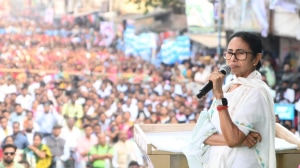Good news aplenty, just don’t talk of inflation
For anyone wanting to gauge the pulse of the government today, Economic Survey 2006-07 would be a useful tool.

For anyone wanting to gauge the pulse of the government today, Economic Survey 2006-07 would be a useful tool. All policy-defining keywords — inflation, growth, special economic zones (SEZs), infrastructure and even pension reforms — have been discussed, keeping the governing coalition’s priorities and achievements in mind. In short, this ‘economic’ survey has far more ‘political’ undertones than many in the past.
Typical of finance minister P Chidambaram’s style, while being optimistic it is cautious. Right from the word go, if in the first line the survey celebrates growth, the second one tones it down by raising the i-word: “There are some genuine concerns on the inflation front.” Chidambaram’s oft-repeated line, “this growth (9 per cent plus) is not an accident” is echoed here as well.
While the finance ministry has been jumping from one defence to another to justify rising inflation (from blaming industry to inflation being a natural ally of a growing economy), in this survey, there is finally some semblance of data-supported analysis. The culprit: primary articles — food including cereals, pulses and suchlike — which rose 9.76 per cent on January 20, 2007 compared to 5.78 per cent a year ago, contributing more than one-third to overall inflation.
It shows groundnut oil, moong, urad and onions all rose by between 23-26 per cent. Dry chillies rose 62.4 per cent, wheat, 11.8 per cent. Many of which are reflected in global prices, resulting in “price shocks”.
Taming this volatile animal has not been easy. While increasing supplies has been one strategy, the other has been to control money supply.
Once inflation is out of the way, there is good news aplenty. Take taxes: The survey notes that India’s tax-GDP ratio is expected to rise from 8.8 per cent in 2002-03 to 11.2 per cent. The numbers for direct taxes would bring a smile to any finance minister. Direct taxes are expected to rise 31.5 per cent to Rs 210,684 crore by March 31, 2007, indirect taxes by 15.7 per cent to Rs 230,566 crore, raising gross tax revenues by 20.8 per cent to Rs 442,153 crore.
But the most impressive results will come from service tax, which is expected to rise, on a smaller base, by 49.6 per cent to Rs 34,500 crore, as the number of services rises from 84 to 99 (expect some more service categories to come under the tax axe tomorrow) and the tax rate from 10 per cent to 12 per cent. Given strong corporate earnings in the past three quarters, however, we believe these numbers will be higher. Will Chidambaram, in keeping with the strategy of lowering rates to capture volumes, therefore, lower rates tomorrow?
The overall picture of growth mirrors in FDI numbers as well. India has surpassed South Korea to become the fourth largest recipient of FDI in the region, the survey notes – between April and September 2006, total FDI inflows stood at $4.38 billion. But most of this has gone to Delhi, UP and Haryana in the north (24 per cent) and Maharashtra, Dadra and Nagar Haveli, Daman and Diu in the West (21.52 per cent). Other regions need to rev up their dollar attractiveness. As also sectors other than the big three – electrical equipment including software attracted the highest share (17.54 per cent), followed by financial and non-financial services (12.69 per cent) and telecom (10.39 per cent).
On SEZs, the survey is non-committal. It lists concerns — generation of little new activity, revenue loss, large-scale land acquisition by developers leading to displacement of farmers with meagre compensation, acquisition of prime agricultural land with implications on food security and so on, concluding that while globally they are viewed as instruments to “enhance the acceptability and credibility of transformation policies to attract domestic and foreign investment and generally for opening up of the economy”, it underlines India’s experience with export processing zones, a precursor to SEZs, with gloom.
Moving from gloom to boom, it is the survey’s capital and commodity markets chapter that sparkles. Capital raising from IPOs maintains the momentum of the past three years — 75 IPOs collected Rs 32,672 crore from the public in 2006. Based on number of transactions, NSE and BSE rank No. 3 and No. 6 across the globe. In terms of market cap as a percentage of GDP, India at 91.5 per cent matches South Korea’s 94.1 per cent or Japan’s 96.0 per cent, and is much better placed than China’s 33.3 per cent.
So, why are we frowning? Is it because the Sensex has fallen 5 per cent over the past month? Is it because inflation is eating into our budgets? Or could it be that we are missing the bigger picture — growth?
Two issues, three priorities
The survey highlights “two issues and three priorities”. The issues: “Sustainability of high economic growth with moderate inflation; and inclusive nature of such high growth.” The demographic dividend, sustained increase in savings and investments and improved infrastructure will take care of the former, it says, while progress in education, health and physical infrastructure will take care of inclusion.
The three priorities of maintaining growth, bolstering the twin pillars of growth (fiscal prudence and high investment), and improving effectiveness of government intervention in education, health and support to the needy, would come from progress in social infrastructure, “effective implementation of National Rural Employment Guarantee Scheme is critical for improving inclusiveness. It should reduce poverty and improve rural infrastructure; and any failure to do so will be an indicator of its ineffective implementation.”
The survey also notes that the “mandate of targeting all subsidies sharply at the poor and the truly needy like small and marginal farmers, farm labour and urban poor remains to be implemented”.



- 01
- 02
- 03
- 04
- 05




























